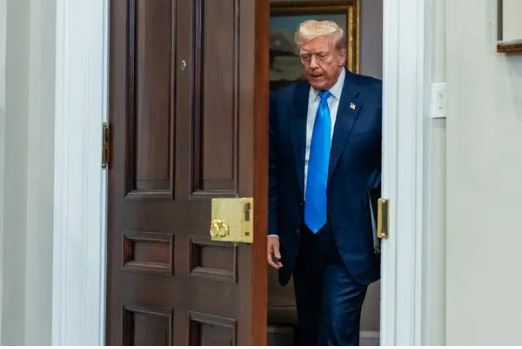Global Trade Faces New Disruption Under Trump’s Sweeping Tariff Expansion
In a move poised to reshape the international trade landscape, former President Donald J. Trump has officially announced the implementation of broad new tariffs targeting dozens of countries across multiple continents. The announcement, made in late July 2025, sent shockwaves through global markets, drawing mixed reactions from trade partners, economists, and domestic industries.
The initiative is part of what the Trump team has branded the “America First Trade Reset”, a comprehensive economic policy platform aimed at reducing the trade deficit, boosting domestic manufacturing, and reasserting U.S. economic leverage on the global stage.
New Tariffs to Take Effect August 1: Key Regions and Industries Affected
The newly announced tariff framework, set to take effect August 1, imposes significant import taxes on a wide array of goods, ranging from steel and electronics to agricultural products and consumer goods. The tariffs will primarily target Asia, South America, and select European nations, many of whom are considered to have unfair trade advantages according to administration officials.
Among the countries facing steep import duties are:
- China: A renewed focus on curbing the trade imbalance, with increased tariffs on tech components, rare earth elements, and machinery.
- Vietnam and India: Penalized for what the Trump team calls “currency manipulation and illegal dumping practices.”
- Brazil and Argentina: Facing fresh tariffs on beef, soy, and agricultural exports.
- Germany and France: Added to the list for what Trump describes as “EU overreach and protectionist car manufacturing policies.”
The revised tariff schedule includes rates ranging between 10% and 60%, depending on the industry and country of origin. For some strategic imports, a 90-day review process has been established, allowing companies to seek exemptions or tariff waivers.
Trump Administration Cites National Security and Domestic Resilience
The Trump campaign argues that the tariff expansion is necessary to safeguard national interests, citing Section 232 of the Trade Expansion Act as a legal basis for the move. “We are no longer going to let other countries exploit American innovation, labor, and intellectual property,” Trump declared during a rally in Michigan, flanked by steelworkers and factory employees.
Supporters claim the tariffs will revitalize domestic production, protect American jobs, and counteract unfair subsidies and dumping practices employed by foreign competitors. “It’s time we stop being the piggy bank of the world,” Trump added, echoing familiar rhetoric from his 2016 and 2020 campaigns.
Mixed Response From Business Leaders and Economists
While Trump’s tariff agenda has been hailed by some segments of U.S. manufacturing, it has drawn fierce criticism from global corporations, trade associations, and even some members of the Republican establishment. The U.S. Chamber of Commerce released a statement warning that “broad, sweeping tariffs will raise prices for American consumers and spark retaliatory actions from key allies.”
Economists warn that increased import costs could fuel inflation, pressure supply chains, and escalate tensions with critical partners such as Canada, Japan, and Mexico. “Tariffs are a tax on American businesses and families,” said Mark Zandi, chief economist at Moody’s Analytics. “This level of disruption could easily trim a full percentage point off GDP growth in the coming year.”
Trade Partners Signal Retaliation and WTO Challenges
Several affected nations have signaled intent to file complaints with the World Trade Organization (WTO) and explore reciprocal tariffs on U.S. exports. In a joint statement, EU officials described the policy as “economically destabilizing and politically provocative,” and confirmed that retaliatory tariffs on U.S. agricultural exports are under review.
China’s Ministry of Commerce called the measures “a flagrant violation of global trade norms,” and vowed a “firm and proportionate response.” Indian trade officials echoed the sentiment, warning of imminent levies on American digital services and pharmaceutical imports.
Domestic Policy Impact and Political Strategy
The tariff rollout aligns with Trump’s broader 2025 campaign strategy, which emphasizes economic nationalism, job creation, and decoupling from global supply dependencies. His messaging centers around strengthening American sovereignty in economic affairs and confronting what he deems a broken global trade order.
Midwestern battleground states, many of which suffered manufacturing losses during prior decades, have shown signs of support. The Trump campaign has capitalized on this sentiment, staging rallies in Rust Belt cities and showcasing small business owners who claim to benefit from reduced foreign competition.
However, key sectors such as retail, automotive, and technology are bracing for disruption. The National Retail Federation issued a forecast predicting increased consumer prices in electronics, clothing, and appliances starting Q4 2025.
Legal Challenges and Judicial Scrutiny
Legal experts anticipate a flurry of lawsuits challenging the administration’s use of emergency trade powers. The U.S. Court of Appeals for the Federal Circuit has already scheduled hearings to examine whether the executive order exceeds the scope of Section 232, particularly in its targeting of countries not traditionally seen as threats to national security.
Civil liberties groups and multinational corporations are preparing coordinated legal strategies, citing due process violations, lack of Congressional oversight, and arbitrary tariff calculations.
Markets React: Volatility and Capital Shifts
Financial markets reacted with volatility in the hours following the tariff announcement. The Dow Jones Industrial Average dropped nearly 400 points, while commodity prices soared on expectations of reduced global supply chains.
- Steel and aluminum stocks surged.
- Tech companies with international manufacturing contracts saw steep declines.
- The U.S. dollar weakened against key currencies amid global uncertainty.
Foreign investment analysts suggest that capital may shift from emerging markets to more insulated economies, as global trade networks recalibrate in response to the escalating tensions.
Conclusion: A Defining Moment for U.S. Trade Policy
Trump’s sweeping tariff plan marks one of the most significant shifts in U.S. trade policy since World War II, pushing America further into a protectionist stance that could either reinvigorate domestic industry or isolate the country from crucial global trade ecosystems.
As the world watches and markets react, the ultimate outcome of this tariff gamble remains uncertain. What is clear, however, is that Trump’s vision for global commerce diverges sharply from decades of bipartisan consensus, setting the stage for a contentious chapter in international economic relations.
Keywords: Trump tariffs, 2025 trade war, Trump global tariffs, U.S. import taxes, Section 232 trade law, tariff retaliation, Trump protectionism, Trump economic policy, sweeping tariffs, global trade disruption.

